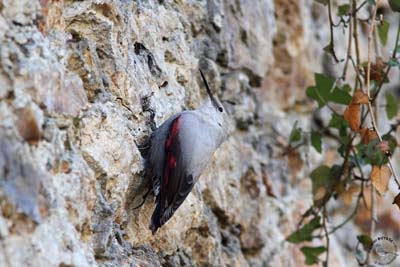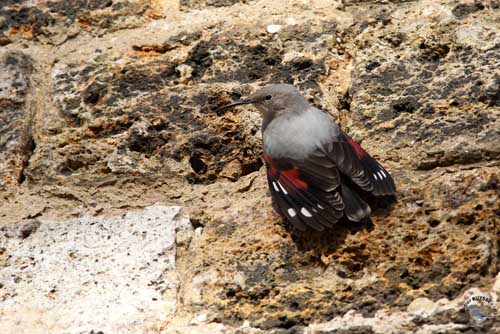
Wallcreeper
Tichodroma muraria
Passeriforme Order – Tichodromadidae Family
BIOMETRICS:
Length: 16-17 cm
Weight: 17-19 g
DESCRIPTION:
Previously associated to nuthatches and creepers, the Wallcreeper is today the single member of the Family Tichodromadidae.
Several morphological and behavioural differences with these genera are relatively conspicuous, involving an unique species.
PROTECTION / THREATS / STATUS:
Wallcreeper is fairly common but sometimes difficult to observe, due to the inaccessible mountainous habitat.
This species is protected in most European countries, but listed as “critically endangered”, “vulnerable” and “near threatened” in Poland, Liechtenstein and Slovakia. It is red-listed in Germany.
Wallcreeper is threatened by the development of human leisure activities in mountains such as rock-climbing, causing disturbances in breeding areas.
Fr : Tichodrome échelette
All : Mauerläufer
Esp : Treparriscos
Ital : Picchio muraiolo
Nd: Rotskruiper
Russe: Стенолаз
Sd: Murkrypare
Photographer:
Didier Buysse
Vision d’Oiseaux
Text by Nicole Bouglouan
Sources:
HANDBOOK OF THE BIRDS OF THE WORLD Vol 13 by Josep del Hoyo-Andrew Elliot-Jordi Sargatal - Lynx Edicions – ISBN: 9788496553453
L’ENCYCLOPEDIE MONDIALE DES OISEAUX - Dr Christopher M. Perrins - BORDAS - ISBN: 2040185607
THE HANDBOOK OF BIRD IDENTIFICATION FOR EUROPE AND THE WESTERN PALEARCTIC by Mark Beaman, Steve Madge - C.Helm - ISBN: 0713639601
BirdLife International (BirdLife International)
Pájaros de España (JL Beamonte)

Adult male in breeding plumage has grey upperparts. The broad, rounded wings show striking pattern with carmine-red lesser and median coverts, and some red-pink on the alula, whereas primary and greater coverts are duller. The flight feathers are dark grey with carmine-red bases of outer edges, and sooty black tips. We can see two white spots on each of the four outer primaries.
This conspicuous pattern is well visible in flight.
The uppertail is black with grey tip, and white edges on external rectrices. The tail is short and squared.
On the underparts, chin, throat and breast are black (of variable extent according to each bird). The rest of the underparts are dusky grey.
Underwing coverts and axillaries are pale red-pink.
On the head, crown and nape are grey. Forehead, lores, cheeks and ear coverts are black.
The long, thin and slightly curved bill is black. Eyes are dark brown. Legs and feet are black.
Feet are fairly large with long toes and strong, sharply decurved claws. The hind toe is longer and slightly less decurved than the others, well adapted to the behaviour of this species.
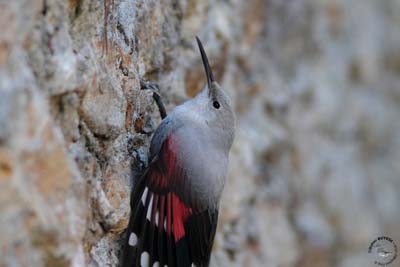
Female is slightly different with lower throat and upper breast greyish-white with black patch of variable size.
In non-breeding plumage, both sexes are paler grey above, and have whitish chin, throat and breast, without black throat patch.
Juvenile is similar to non-breeding adults with brownish throat and more uniformly grey plumage.
We find two subspecies:
T.m. muraria
T.m. nepalensis with longer wings and shorter bill, larger white spots on wings and tail, darker grey plumage, buff-brown wash on the head and tinged pink tail base.
VOICE: SOUNDS BY XENO-CANTO
Wallcreeper is vocal all year round.
At start or end of breeding season, it utters ascending clear whistles with lower end note. Outside breeding season, both sexes sing as advertising calls for territory.
The race “nepalensis” utters rich whistled notes, gently rising, followed by high-pitched note.
We can also hear short trills and warblers. The female sings mainly on the winter areas.
Wallcreeper utters whistled “tschirp” as contact call.
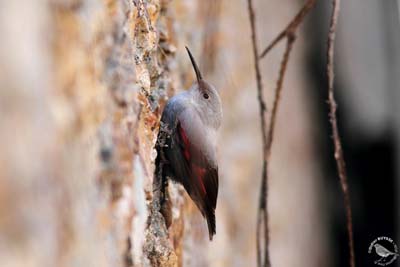
HABITAT:
Wallcreeper frequents several types of rocky areas with steeps, cliffs and boulder-strewn slopes and gorges in mountains. This species needs holes and crevices for nesting and roosting. The habitat often includes rocky and grassy ledges, vegetation such as moss, shrubs and trees, and running water.
Wallcreeper forages as well in sunlit and shaded areas.
During winter, it frequents similar rocky areas at lower level such as carries and sea cliffs, also buildings in cities.
According to the subspecies, this bird may be seen between 350 and 3500 metres of elevation in Europe, and largely above in Himalayas (between 1500 and 3600 metres), and more in Tibetan regions (up to 5000 metres).
RANGE:
Wallcreeper can be seen in the high mountains of Eurasia.
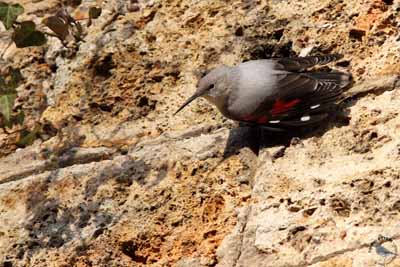
BEHAVIOUR:
Wallcreeper usually forages alone, searching for insects, spiders and some other invertebrates.
The bird progresses by short jerky hops along the rocky cliffs and walls, performing also sidling, creeping and walking. Along the vertical surfaces, it may perform upwards leap helped by single rapid wing beat.
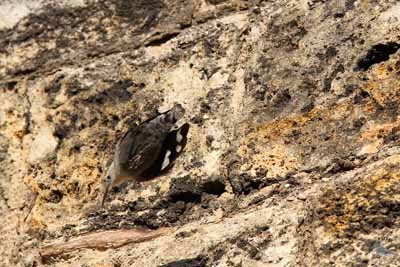
Wallcreeper catches the prey from the rock surface or among the vegetated ledges. It searches for insects in several holes and tunnels and extracts invertebrates from the rocky crevices. It may occasionally take preys in flight. It also forages on the ground, using its closed bill for turning the leaf litter.
The largest preys are carried to a flat stone and beaten against the surface until dismembered.
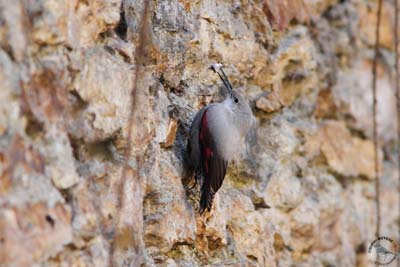
Pair forms after the Wallcreepers return from the wintering areas. The male takes off from the entrance of the chosen hole, and performs alternated glides and wing flapping within a small area, sharp turns and steep ascents and dives. If a female approaches, it enters the cavity while singing, and also sings inside.
The male also performs head-up posture, in order to display the black bib. Before the copulation, it sings persistently with the neck held forwards and dropped wings. Then, it lands close to the female and mounts her. Copulation occurs during short period of a few days before the laying.
Wallcreeper is migratory, mainly short distance and altitudinal migrant, according to the season. During winter, it can be seen at lower level, even in cities.

FLIGHT:
Wallcreeper has large, broad wings allowing the bird to take advantage of the updraughts present in the mountains to reach the higher foraging areas with minimal effort.
This bird often performs wing-flicking, which is a typical feature of this species.
It has agile flight with great manoeuvrability, making it able to avoid predators’ attacks.
REPRODUCTION:
Breeding season occurs in April-May and July-August in Europe and May-July in Himalayas.
Wallcreeper is monogamous and produces single brood.
It is solitary nester and territorial, defending the nest-site and the territory against predators and intruders.
The nest is situated in hole or cavity, in rock crevice, boulders and even in buildings. The nest is made with moss, plant fibres, rootlets and grass.
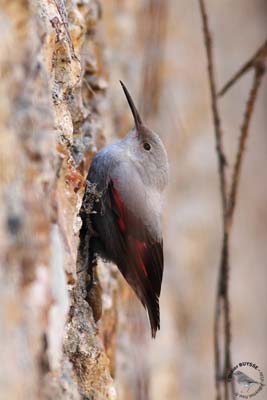
Female lays 3-5 spotted dark red to blackish eggs. Incubation lasts about 19 days, by female.
Chicks are fed by both parents. The male brings the food while the chicks come to the entrance.
They fledge about one month after hatching, and they still depend on parents for several days, between 5-6 and 7-12 days after leaving the nest.
Young reach the sexual maturity at one year for females and at two years for males.
DIET:
Wallcreeper feeds primarily on insects, adults, larvae and eggs. It catches damselflies, Plecoptera, grasshoppers and crickets, bugs, Lepidoptera and Diptera, ants, bees and beetles.
It also takes spiders, small molluscs and other invertebrates.
